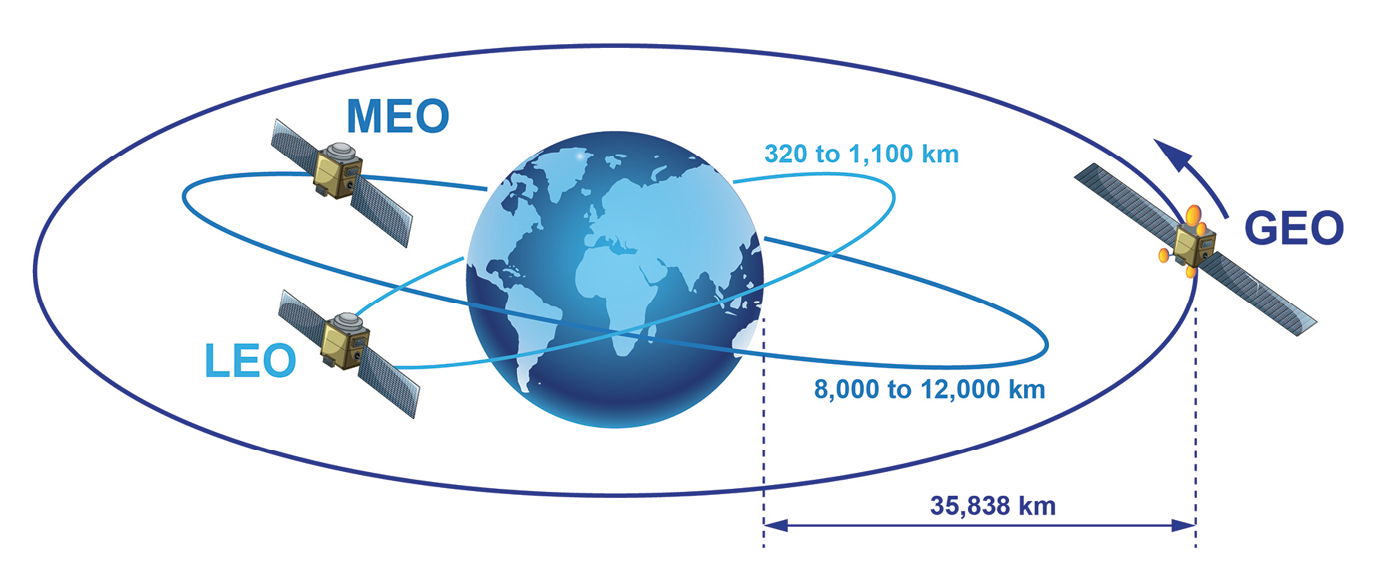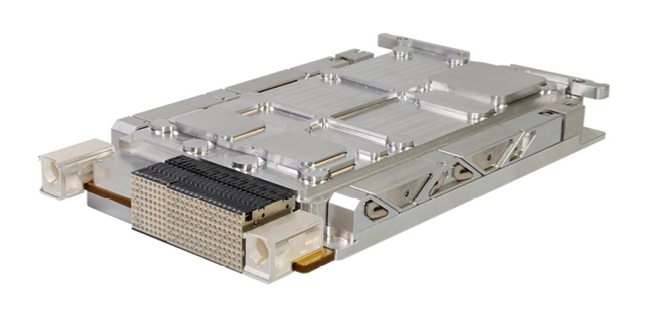Almost 5,000 artificial satellites orbit our planet with just over 1,900 of them operational. These satellites provide us with communication networks, Global Navigation Satellite System (GNSS) coverage, technological research, as well as scientific and Earth observation data.
Historically, our military forces utilized geosynchronous equatorial orbit (GEO) satellites for their reconnaissance and communications networks. These satellites orbit at an altitude of approximately 22,300 miles above the Earth’s surface and therefore have a large field of view. They orbit over the equator at the same rate as the Earth’s rotational period, appearing to be stationary in the sky.
Three GEO satellites placed 120 degrees apart longitudinally can provide full Earth coverage with the exception of a small section around each of the north and south poles. GEO satellites, also favored for meteorology, TV and radio broadcast, have typically been custom-designed units taking more than ten years to develop and averaging more than $500 million to build with at least an equal amount spent on launch and operation. With the speed of advancements by adversaries and new emerging technologies, these 15- to 20-year lifespan custom satellites limit the United States’ ability to easily and routinely add new capabilities or technology to their satellite program. Due to these challenges, NASA and other government agencies determined they needed a new approach to maintain space and military superiority.
Space: The Final Frontier, but let’s not go that far
Commercial companies with massive amounts of funding like SpaceX, OneWeb, and Planet led the way of the small satellite movement with the primary goals of providing global imagery and the infrastructure to deliver internet coverage to all areas of the globe. They provide these services to not only the U.S. government but also to public and private companies. These smaller low Earth orbit (LEO) satellites occupy much lower altitudes of just 1,200 miles above the Earth or less. While there are some satellite constellations in medium Earth orbit (MEO) (the area between GEO and LEO) such as the GNSS GPS, BeiDou, GLONASS and Galileo constellations, the majority of existing and new constellations will continue to be in LEO. (Figure 1.)
 |
(Click graphic to zoom)
|
It only makes sense that to stay ahead of our adversaries, the U.S. government would realize the value of these smaller, more agile LEO satellite constellations to provide more reconnaissance data at a fraction of the cost and time of their geostationary counterparts. Additionally, in LEO, satellites travel at different longitudes providing full Earth coverage with substantially better signal strength – 1,300x that of geostationary satellites – so data arrives faster with lower latency.
The Defense Advanced Research Programs Agency (DARPA) launched the Blackjack program in early 2018 to create a constellation of LEO satellites that will provide similar functionality to geostationary satellites at a cost of about $6 million instead of more than $1 billion. These satellites will be “good enough” and use commercial-off-the-shelf (COTS) components with reduced screening, acceptance testing, and life expectancy compared to their GEO counterparts that encounter higher levels of radiation. These satellites in LEO can more effectively be replaced if system failure occurs or if destroyed by collision with other satellites or space debris. The U.S. government can routinely take advantage of leading-edge technologies to acquire, process, store, and disseminate larger amounts of real-time data improving and augmenting current capabilities and satellite networks such as the U.S. global positioning system (GPS). To achieve lower development costs and shorten development schedules, designers of these satellites are taking advantage of what other military and communications systems designers have been doing for over 30 years, designing with open standards.
VITA launches into space
The SpaceVPX VITA 78 specification is the first open standard developed specifically for space applications and builds off the success of the OpenVPX platform that has been widely adopted for military embedded systems due to its high-performance computing capabilities, interoperability and scalability. SpaceVPX strengthens the OpenVPX specification with additional key features for spacecraft and other high-reliability applications such as airborne weapons and mission-critical ground computing systems exposed to ionizing radiation. These include fault tolerance by mitigating vulnerabilities of a single point failure, dual redundant power and management distribution and diagnostic support. The standard intends to maintain compatibility with OpenVPX components and connector pinouts.
SpaceVPX using the RapidIO interconnect protocol for high-performance computing will deliver improvements over other architectures used for space systems using older interfaces with slower data rates like CompactPCI (cPCI) or lacking processor to processor interconnect like PCI Express (PCIe) by enabling multiprocessor fabrics, low latency, and low power. An ideal interconnect for SWaP-optimized [size, weight, and power] systems, RapidIO enables more functionality through connectivity of many different types of processors, from general purpose to digital to FPGAs [field programmable gate arrays], in one system that previously could only be accomplished with multiple, big box application-specific systems. Now complete systems to acquire, process, store and disseminate data can be developed in a small 3U SpaceVPX chassis using standard 100mm x 160mm 3U SpaceVPX single board computers (SBC). System architects can take advantage of the latest innovations from commercial technology leaders by simply upgrading SBCs that integrate the newest high-performance processors and high-density storage from an ecosystem of suppliers without a system redesign. Conversely, systems developed using custom architectures require a substantial redesign effort to implement next generation interconnect and processing technologies.
Storage is always an issue – Until now
Logically, new high-capacity data storage solutions are necessary to support the growing data acquisition and processing demands of the LEO constellation expansion. Dedicated data recording systems previously developed are unsuitable for these SWaP-constrained, lower cost satellites. As a result, a high-density, modular SpaceVPX solid-state-drive (SSD) was developed to satisfy this need.
Taking its expertise in secure SSD devices (Figure 2), sensor-processing solutions, and the OpenVPX standards for terrestrial military applications, Mercury Systems began development of a family of SpaceVPX products including the first space-grade storage drive in a 3U SpaceVPX form factor.
 |
(Click graphic to zoom)
|
Similar to a traditional military-grade SSD, this drive uses high endurance, large geometry Single Level Cell (SLC) NAND flash, and integrates an internally developed NAND controller containing error correction (ECC) algorithms.
Providing fault tolerance and data integrity, the advanced ECC algorithms counter radiation-induced NAND flash errors by correcting byte errors and failing devices while automatically replacing worn NAND blocks. All other components in the drive are radiation tolerant by design to 100 Krad. With 100 percent authority over the NAND controller, these devices are customizable in feature and form factor to meet mission specific requirements. Designed to meet the SpaceVPX specifications, these devices provide high-speed data rates (>9000 Gb/s) not seen in competing storage products using older standards or custom solutions through the Serial RapidIO (SRIO) interface. With interoperability, scalability and cost at the heart of open standards, these devices operate with the ecosystem of SpaceVPX products, providing a path to routine system upgrades not available with custom storage devices.
To learn more about the VITA 78 SpaceVPX specification, visit www.vita.com/Tutorials.






